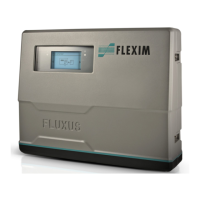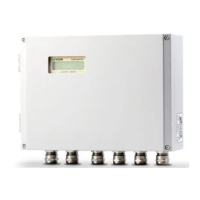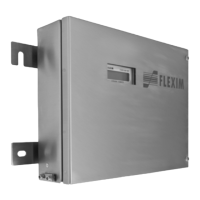7 Connection
FLUXUS WD 7.1 Transducers
53
UMFLUXUS_WDV1-3EN, 2018-07-16
7.1 Transducers
It is recommended to run the cables from the measuring point to the transmitter before connecting the transducers to
avoid load on the connectors.
7.1.1 Connection of the transducer cable to the transmitter
• Remove the blind plug for the connection of the transducer cable.
• Open the cable gland of the transducer cable. The compression part remains in the cap nut.
• Push the transducer cable through the cap nut and the compression part.
• Prepare the transducer cable.
• Shorten the external shield and brush it back over the compression part.
• Screw the sealing ring side of the basic part into the transmitter housing.
• Insert the transducer cable into the housing.
• Fix the cable gland by screwing the cap nut onto the basic part.
• Connect the leads of the transducer cable to the terminals of the transmitter, see Fig. 7.2 and Tab. 7.1.
If transducers are replaced or added, the sensor module also has to be replaced or added, see section 7.1.5.
Fig. 7.1: Connection of the transducers to the transmitter
1 – transducers (measuring channel A)
2 – transducers (measuring channel B)
The degree of protection of the transmitter is only ensured if all cables are tightly fitted using cable glands and the
housing is firmly screwed.
For good electromagnetic compatibility (EMC), it is important to ensure good electrical contact between the external
shield and the cap nut (and thus the housing).
A
B
SNAP
DISP
DISP
MODEFAST
MUX
NEXT
Q
ON
Q+Q-
3x Q
OFF
LAN
USB
A+
B-
P1+
P2+
P3+
P4+
P5a
P6a
P7a
S
S
P1-
P2-
P3-
P4-
P5b
P6b
P7b
X2 X3
X_AV
KL11
KL12
KL7KL8
KL9KL10
KL4
X_AR X_BV X_BR
T1A
T1B
S1
T2A
T2B
T3A
T3B
S3
T4B
T4A
T1a
T1b
S1
T2a
T2b
T3a
T3b
S3
T4b
T4a
N(-)
PE
L(+)
AV
AVS
AGN
ARS
AR
BV
BVS
BGN
BRS
BR
X2 X3
X_AV
KL11
KL12
X_AR X_BV X_BR
AV
AVS
AGN
ARS
AR
BV
BVS
BGN
BRS
BR

